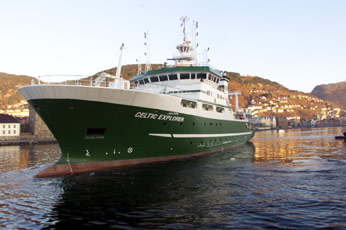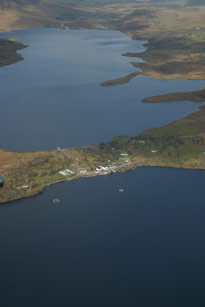| 2003 |

|
YEAR BOOK |
Marine Institute
|
Marine Institute building marine RTDI infrastructure
|

These latest developments will greatly facilitate the Marine Institute's mission to promote a thriving maritime economy in Ireland in harmony with the ecosystem by enhancing the seven service areas within the Institute. These are Fisheries Science Services, Marine Environment and Food Safety Services, Strategic Development and Planning Services, Ocean Science Services, Corporate Services, the Irish Maritime Development Office, and Aquaculture and Catchment Management Services.
For more information on the Marine Institute Services visit www.marine.ie
Celtic Explorer Sets Sail
The �30 million national research vessel, Celtic Explorer, was commissioned in April 2003. Its 45 day long mission capability will allow Irish scientists to explore the furthest limits of our marine territory and beyond. The new Irish research vessel is 65.5 metres long and accommodates 31 personnel, including up to 19 scientists. The Celtic Explorer is also the world's most silent research vessel, complying fully with noise requirements laid down by the International Council for the Exploration of the Seas.
The Celtic Explorer set sail on the first five month leg of the National Seabed Survey in May 2003 - an initiative being undertaken by the Geological Survey of Ireland and the Marine Institute, which aims to provide detailed maps of Ireland's underwater territories over the next three years. During this time, other scientific work will 'piggyback' on the vessel while at sea. From October until the end of the year, the Explorer will work on the Marine Institute's annual groundfish survey over the continental shelf, Irish Sea, Celtic Sea and the west coast of Ireland. During this time, she will link up with the Scottish research vessel, the RV Scotia, and the French research vessel, the RV Thalassa. This comprehensive international survey will be used to monitor fish stocks and the environment in which they live.
The RV Celtic Voyager continues to work on fisheries surveys, environmental monitoring and inshore mapping projects and is available for charter by other research agencies and third level institutes. For more information on the national research vessels visit www.marine.ie/rv

�2.3m invested in wild fisheries and aquaculture research centre
Upgraded and extended Marine Institute research facilities located in the Burrishoole Valley, in Newport, Co. Mayo, were officially opened by Minister Dermot Ahern TD on 13 June 2003. The facility forms one of the greatest natural laboratories for studying Atlantic salmon and has been a base for research on salmon, eels and sea trout since 1955. The site was originally selected by the Salmon Research Trust because of its location between a saltwater lake (Furnace), and a freshwater lake (Feeagh) - so that all upstream and downstream movements of fish could be counted. Every single fish moving upstream or downstream since 1970 has been manually counted through the fish trapping system at Burrishoole. This has provided the Marine Institute and colleagues throughout Europe with a unique insight into the comings and goings of long distance migrants such as salmon and eels. In combination with the new laboratory facilities, the Burrishoole catchment and neighbouring Clew Bay also provide a unique platform for the development and testing of a wide range of environmental management models.
The information collected in the Burrishoole system is used by the International Council for the Exploration of the Seas to gauge the overall status of the Irish stocks on an annual basis, and is one of the key index systems for salmon, sea trout and eel in the north Atlantic. The research carried out here assesses impacts on the survival and abundance of the salmon stock and is fundamental to the development of salmon Total Allowable Catches (TACS).
New headquarters in Oranmore, Co Galway
As well as serving science at sea with its research vessels, the Marine Institute is building a network of world-class facilities around the country, from Dublin to Newport and Galway. Work started in September on the new headquarters in Oranmore, Co Galway, which will support the delivery of excellence in the services provided by the Institute. The facility will incorporate the latest concepts and innovations in laboratory and office design to meet specialist and international accreditation requirements, as well as providing a safe and enjoyable working environment.
Ireland is fast becoming an international centre of excellence for marine research, technology, development and innovation (RTDI). The Marine Institute's R&D programmes span a wide range of sectors including: marine food safety, environmental monitoring, marine fisheries, aquaculture, marine technology, ocean energy, shipping, and tourism & leisure. The Institute supports industry through RTDI Foresight, industry liaison, research vessel operations and information services. The Institute also provides competitive marine research funding programmes under the National Development Plan.
Contact: Lisa Fitzpatrick, Communications & Marketing Officer, Marine Institute,
Galway Technology Park, Parkmore, Galway;
Tel: 091-730400; Web: www.marine.ie